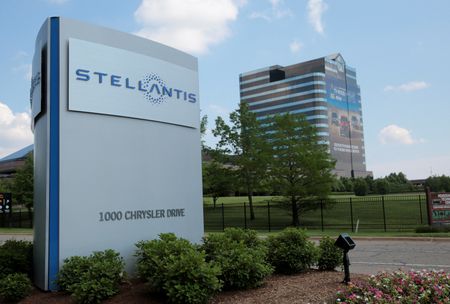By Nathan Gomes
(Reuters) -The United Auto Workers (UAW) union expects to go on strike against the Detroit Three automakers later this week if no agreement is reached over new contracts, setting the stage for one of the largest worker actions this year.
The current contracts at General Motors, Ford and Chrysler parent Stellantis are set to expire this Thursday at 11:59 p.m. ET.
The potential strikes come as Detroit automakers, like their global counterparts, have been focused on cost reductions, which in some cases include job cuts, to help accelerate a shift from gasoline-powered vehicles to electric vehicles (EV).
WHO IS THE UNION NEGOTIATING WITH?
The UAW kicked off negotiations with GM, Ford and Stellantis in July, but is yet to agree on a deal.
According to GM’s annual filing, about 46,000, or 44%, of its U.S. employees were represented by unions, and a majority of them by the UAW.
Ford’s annual filing showed about 57,000 of its hourly employees in the United States were represented by the UAW, while the UAW represents about 43,000 U.S. hourly workers at Stellantis.
The UAW has historically picked one of the Detroit Three to negotiate with first as the so-called target that sets the pattern on which subsequent deals are based.
UAW’s new president, Shawn Fain, had promised that things would be different this time and has said that “there will be a strike at all three, if need be”.
WHAT ARE THE CURRENT OFFERS FROM THE DETROIT THREE?
Ford has offered a 9% wage increase through 2027 and 6% lump sump payments. Company officials later confirmed that the automaker boosted its offer to 10% in wage hikes along with the lump sum payments.
GM followed with a 10% wage hike and two additional 3% annual lump sum payments over four years.
Stellantis last week offered its U.S. hourly workers a 14.5% wage hike over four years, but no lump sum payments.
WHAT DOES THE UAW HAVE TO SAY ABOUT THE OFFERS?
The union has rejected all three offers.
“We want a deal. We are ready for a deal. But it’s got to be a deal that honors our sacrifices and contributions,” UAW president Shawn Fain said last week on Facebook Live.
He added that there would be a strike at all the three automakers if no agreement is reached before the deadline.
WHAT ARE THE UNION’S DEMANDS?
The UAW is pushing automakers to eliminate the two-tier wage system under which new hires earn as much as 25% less than veterans.
Fain has said repeatedly the union will push to restore pay improvements tied to the cost of living and retiree benefits cut during the 2008-2009 economic crisis.
The UAW also wants strong salary increases given the financial success of the automakers, citing generous executive payouts and large U.S. federal subsidies for EV sales.
Fain also is aiming to get agreements that would allow the UAW to represent hourly workers at joint-venture EV battery plants opened or planned by the Detroit Three.
The UAW has been wary of the industry shift to EVs and called on the Biden administration to soften its proposed vehicle emission cuts that would require 67% of new vehicles to be electric by 2032.
EVs require fewer parts to build and industry officials have said that will result in a need for fewer workers. Fain has said there should be no jobs lost because of the EV shift.
WHAT DO AUTOMAKERS WANT?
The Detroit Three want to close the cost gap they have with foreign automakers with non-unionized U.S. factories.
Ford sources estimate that their U.S. labor costs are $64 an hour, compared with an estimated $55 for foreign automakers and $45 to $50 for EV leader Tesla.
The companies also want greater flexibility in how it uses its U.S. workers to increase efficiency and cut costs as the industry shifts to EVs.
WHAT IS AT STAKE?
A potential strike could hit at a time when automakers are ramping up efforts to maximize gasoline and EV vehicle production to capitalize on demand for new vehicles.
A strike would be another blow, following supply-chain disruptions that hurt production and profits during the pandemic.
In fiscal 2019, GM’s fourth-quarter profit took a $3.6 billion hit from a 40-day UAW strike that shut down its profitable U.S. operations.
Impacts of the potential strike could also trickle down and squeeze quarterly profits for auto part suppliers such as Aptiv, Lear Corp and Magna.
Contract talks between the UAW and the Detroit automakers have gone on till the strike deadline and beyond in past years.
WHAT DO ANALYSTS EXPECT?
Analysts rate the chances of a strike at more than 50%.
“Time is quickly running out on what may be an extended walkout against all Detroit Three OEMs ” Evercore ISI analyst Chris McNally said.
A ten-day strike by the UAW could cost manufacturers, workers, suppliers and dealers more than $5 billion, according to a new analysis by the Anderson Economic Group, an economic consulting firm.
(Reporting by Nathan Gomes in Bengaluru and Ben Klayman in Detroit; Editing by Shounak Dasgupta)





